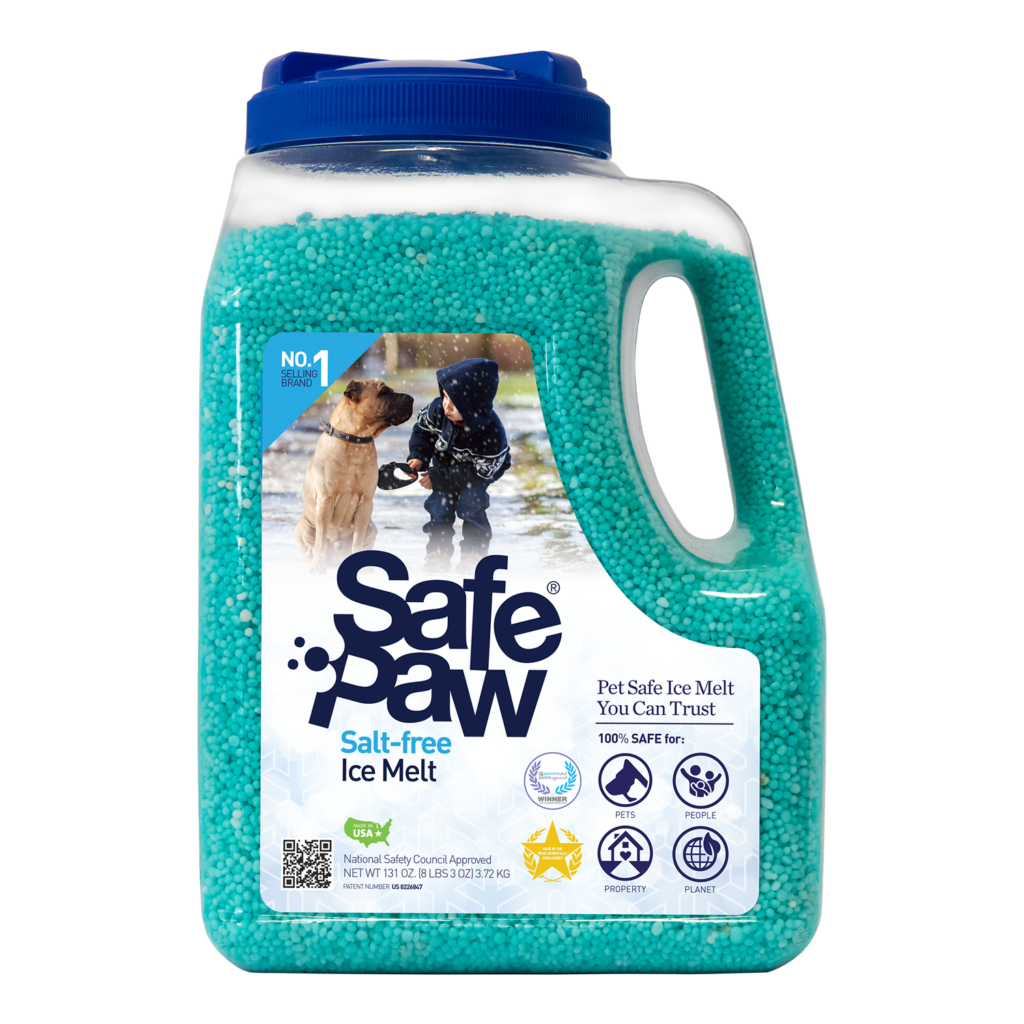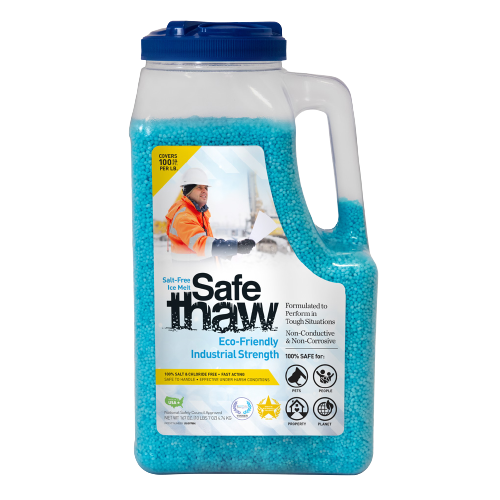What To Use On New Concrete To Add Traction

Winter brings the most lovely moments, such as families playing in the snow, friends gathering around the fireplace, ski adventures, etc. But it also increases weather-related concerns. One of the most crucial of these is slip and fall accidents due to the lack of traction on snow.
As we feel that we have fixed our winter woes, we are introduced to a new problem in the spring: fractured concrete. The freeze-thaw cycle and the toxic chemicals that we unknowingly use in winters bring up this damage. So, let’s figure out how to make our new concrete last longer without scaling or popping out.
Two Most Common New Concrete Foes
Rock Salt: Rock salt is a mineral form of sodium chloride (table salt). It keeps roadways from becoming icy and is an anti-slip traction agent. It lowers the freezing point of water but at the same time can be dangerous to your new concrete. Because salt is slightly acidic, it breaks down the chemical linkages that make the concrete strong. Another factor that aggravates the matter is that most driveway concrete has steel that weakens when exposed to salt. It can be exceedingly damaging to grass and bushes, as well as nearby water bodies.
Sand: Sand does not melt ice as rock salt does. It has an abrasive quality which makes it an anti-slip traction agent. Sand is only effective if it is on the ice’s surface and needs to be reapplied when it gets covered by snow. As excessive amounts of sand can accumulate in drains and drainage areas, it’s critical to sweep up sand after storms, or you’ll have problems in the spring.
Get ready for winter with Traction Magic instant grip on snow and ice
Is Ice Melt Safe For Your New Concrete?
Ice melt should not be applied to new concrete as its chemicals cause irreversible damage. While your concrete contractor may claim that concrete cures in 28 days, that is not the case. It’s true that after four weeks, concrete can be sealed but the chemical changes to harden it takes much longer.
It is a known fact that ice melt and salt products are hazardous to our concrete. Sodium chloride, potassium chloride, calcium chloride, and magnesium chloride are the typical salts used to melt snow. These chemicals cause corrosion effects causing cracks and flakes to appear on concrete.
What To Use On New Concrete To Add Traction?
We know it is not safe to use ice melt on new concrete then, how can we overcome the problem of slippery walkways and driveways? The solution lies in using natural traction agents.
As a new concrete owner, you need to be more cautious about the compounds you use on it and, these natural traction agents are free from salts and chemicals.
These agents create a solid layer on a surface to provide better footing for traction on snow. Firstly, they absorb excess water that makes ice less slippery. Then, the gripper granules dig into the ice and create a dry, non-slippery layer.
How Do You Add Traction to Concrete?
Adding traction to concrete is essential to prevent slips and falls, especially in icy conditions. Here are some methods to improve concrete traction:
- Texture the Surface: During the concrete pouring and finishing process, you can add texture to the surface using brooms or specialized concrete stamps. This creates a rougher surface that provides better grip.
- Apply a Concrete Sealer with Grit: There are concrete sealers available with added grit or nonslip additives. These sealers not only protect the concrete but also enhance traction.
- Use Anti-Slip Coatings: Anti-slip coatings or paints designed for concrete surfaces can be applied to enhance traction.
- Utilize Abrasive Additives: Some abrasive additives, such as aluminum oxide or fine sand, can be broadcast onto freshly applied concrete to improve traction.
Get ready for winter with Traction Magic instant grip on snow and ice
How Do You Make Concrete More Grippy?
To make concrete surfaces more grippy, consider the following steps:
- Regular Cleaning: Keep concrete surfaces free of debris, dirt, and algae, as these can make the surface slippery.
- Use Nonslip Mats or Rugs: In high-traffic areas, especially during winter, use nonslip mats or rugs to provide extra traction.
Shoe Ice Grips, Traction & The Invisible Threat of Black Ice on Roads
While techniques like broom-finishing and anti-slip coatings can help add grip to concrete during construction, everyday winter hazards often require more immediate, user-friendly solutions. Many homeowners resort to shoe ice grips—slip-on cleat devices designed to provide better traction on icy sidewalks or driveways. These can help you walk more securely, especially when carrying groceries or guiding children across snow-covered surfaces.
What is black ice on roads
However, even shoe grips can fall short when you encounter black ice traction—a common and underestimated threat. So, what is black ice on roads, and why does it matter for concrete care? Simply put, it’s a transparent layer of ice that forms when temperatures drop rapidly and moisture on the ground freezes into a thin, glassy sheet. Because it’s so clear, it often blends in with the pavement, making it practically invisible to the human eye.
When does black ice form
You may wonder, when does black ice form? It typically appears in the early morning or late evening when the air is cold but the roads look deceptively clear. Shaded sidewalks, concrete steps, and new driveways that don’t get much sun are particularly prone to black ice formation. That’s also why is it called black ice—not because of its color, but because it allows the black surface below (like asphalt or dark concrete) to show through, giving no visual cue that the ground is icy.
Traction Magic- The Superstar
And if you’ve heard the term what is black ice crystal, it refers to the thin crystalline structure of this slick ice layer that forms without trapped air bubbles, making it denser and more dangerous. Even the best shoe ice grips can slip on untreated black ice if there’s no granular surface for them to latch onto. That’s where Traction Magic becomes invaluable. Instead of adding chemicals that damage your new concrete, it introduces a layer of non-toxic granules that absorb surface moisture and embed themselves into ice, creating a dry, textured area that’s safe to walk or drive on—without damaging your surface.
- Apply Traction Magic: Traction Magic is a natural volcanic rock-based product that can be sprinkled on icy or snowy concrete surfaces to provide instant traction. It’s safe for concrete, pets, and the environment.
Wrapping up
Protecting new concrete in winter isn’t just about avoiding cracks and corrosion—it’s also about preventing accidents. While shoe ice grips and anti-slip coatings have their place, they don’t solve the problem of hidden dangers like black ice. When facing unpredictable conditions, Traction Magic stands out as the best choice to provide traction safely and instantly. Free of salts and chemicals, it not only keeps your surface intact but also your family secure. Choose wisely. Walk confidently.

FAQs
Other Ice Melt Products
Safe Paw
The Original and the #1 Pet and Child Safe Ice Melt for over 20 years. Guaranteed environmentally safe – will not harm waterways and sensitive wetlands. Safe Paw can change how winter affects our planet.

Safe Thaw
Imagine an ice melt you can put down and never worry about. It won’t harm pets, kids and your property. That’s Safe Thaw. Unlike anything else on the market, Ice and Snow Management You Can Trust.
